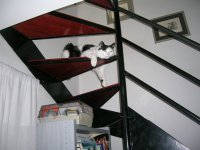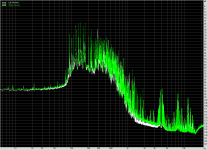Thank you, and what musical instrument produced those?
Really?
Really?
Yes, that was the question. The reason I ask is that as far as I'm aware, correct me if I'm wrong, sidebands are only created due to a system nonlinearity.
Yes, that was the question. The reason I ask is that as far as I'm aware, correct me if I'm wrong, sidebands are only created due to a system nonlinearity.
Um, ok. you stand corrected..😉
The book pic shows a damped sine, there are many instruments which do that..
Bells would be a good example.maybe a xylophone..cymbals are much too messy, (I think they have the kitchen sink somewhere in there.)
Using Scott's difference technique, one could apply it to any high bandwidth recorded instrument sample to see if the sidebands actually do go over a CD brickwall filter.
jn
Can you show me evidence of that please, I'm not being "funny" (for DPH😉) I've looked and can't find anyUm, ok. you stand corrected..😉
As long as you don't get splinters or electric shocks it's living room ready?
If I could run multiple lives, one would be in the industrial design/architecture end of the spectrum, and my diy projects try to bear that out. 🙂
Going from sloshing electrons and air molecules around to *pretty* raises the barrier a lot. Fortunately I've been collecting dead UPS (universal power supply) boxes out of the surplus/recycling bin at work so I just need to gut them and put a pretty faceplate before they can be repurposed. Might get a little emi shielding to boot. 🙂
Can you show me evidence of that please, I'm not being "funny" (for DPH😉) I've looked and can't find any
If you mean by googling, good luck with that. As far as I know, I may be the first person to actually consider envelope modulation sidebands and the impact of brickwall filtering on the final output...lordy, even I fall asleep typing that...😀 But after forty years, I really find it hard to believe I am the first to consider it..and at a point where the format is going south.
It's like that guitar paper billshurv put up. They measured this huge transient acceleration at the pluck, but simply ignored it as it was not their primary concern within the paper. And a huge blip like that won't be easy to find on an FFT as the energy under the blip is small compared to the long tern signal.
jn
Not a characterization but a description of how you had it set up.
6th December 2019: "OK quickly... short version ---> accuracy test. One using no electronic test equip:
Find a person who you know very well. Someone you talk/listen to every day. A male and a female would be nice.
Have that person stand between your speakers and recite something. While they are reciting, record them also. You sit in your usual listening place.
Now play back their recorded voice. Adjust level to be the same as when they talked. Does the reproduced voice sound exactly the same as hearing it "live"?
If it does, you have an accurate system.
You are comparing live voice sound you know well in the same room and space and location acoustics as your music reproduction system. At least for the critical midrange freqs."
Have you ever done live vs. recorded sound accuracy comparison of cello?
Dont worry about it. The well known voice you are to record standing between speakers will tell you a lot. Close mic'ed.
I think you are very confused on how to do it well/correctly. I gave as much details as a person should need. Without further hand holding. You can fine tune it from there for best results. Like what mic to use and you could drag the recording into an anechoic chamber if you prefer. Well considered and applied will give you very good idea/approximation to your systems in situ accuracy. IMO, of course.
THx-RNMarsh
Last edited:
If I could run multiple lives, one would be in the industrial design/architecture end of the spectrum, and my diy projects try to bear that out. 🙂
I always hoped to find a mate who was lousy at soldering and good at metalwork so we could trade!
Perhaps one way to envision it is through consideration of why "windowing" is used in an FFT. The various windowings used appear to me to be a form of amplitude modulation, giving the analyzed signal a "soft start" - and a soft end. Without windowing, the FFT will show frequencies that arent there in a continuous, steady state signal being analyzed.
Attacks in real cymbal envelopes are hardly "soft", particularly considering something like Billy Cobham's small China, which he claims he can make be "the loudest thing in the room" (When that guy hits that particular piece of metal - I believe him) Like a plucked guitar string, I imagine the spectral content of such a thing is time variant, depends on where you hit it, and if there's any musical sound that's wide bandwidth noise modulated by sharp envelopes, that's got to be one of them.
A high Q filter takes time to start up - like a few cycles - even when fed a frequency the same as its tuning. It's like it imparts its own "window" on a sharp envelope signal. Generally speaking, what's the Q of a brick wall filter - high or low? If high, perhaps it's "windowing" the start of all transients (with significant content approaching the cutoff frequency) and that's what's being heard. Even if you cant hear that high a single frequency anymore, you can still hear the "windowing" effects modifying the envelope of what you can hear.
Move the sample rate and corresponding filter out well beyond "22.5" and it sounds more real, because transients are now "windowed" differently by the same or perhaps even lesser Q filter tuned to the appropriate frequency for the higher sample rate.
The above may be all bullsh*t, but how to account for people (who cant hear to 20k...) claiming they can hear artifacts imparted by filters operating almost an octave beyond their tonal perception capability?
Its a nice new interesting interpretation. Something to consider.
Of course, if the system BW was wide enough, no windowing at all would be needed.
THx-RNMarsh
Last edited:
Also to confuse the issue there are small children who respond to dog whistles!
Yesterday noon, I made the mistake to play back (low volume) through loudspeakers this link.
YouTube
My cat who was two meters above the loudspeakers (usually relaxed, doesn’t blink an eye with soprani and tenori high SPLs) went nuts.
He was looking frightened in all directions for an enemy, then started running up-down the stairs, hide under sofas and beds.
I turned the youtube channel off, the cat remained upset for about 2 hours. He didn’t eat and drink but late in the night.
The loudspeakers were two LS3/5A clones
George
Attachments
So, we have AM with a sideband above any chance of audibility, which is then filtered out...
Is this significant?
Is this significant?
Unlikely. They solved that issue decades ago but it takes time for technology to catch up to produce commercially affordable products. How do you think the hires devices and filters got developed? By accident?... I really find it hard to believe I am the first to consider it...
If you mean by googling, good luck with that.
I meant can you show me evidence sidebands are not only created due to a system nonlinearity?
Solving it by simply going to higher rates is not what I meant.Unlikely. They solved that issue decades ago but it takes time for technology to catch up to produce commercially affordable products. How do you think the hires devices and filters got developed? By accident?
I am surprised that I could not find any published literature on the possibility of modulation sidebands hitting the brick wall. Lord knows, I did an awful lot of googling to find it..
jn
Most probably they consider other venues as dead ends or impractical, higher res than redbook equipment has been mainstream for years. Moreover I am not aware of anyone fluent in A/D - D/A stuff contributing in this thread to have meaningful exchange of ideas with you. Detail discussion on esoteric design of digital stuff seems of minor interest for analog folks like me.Solving it by simply going to higher rates is not what I meant...
If you mean by googling, good luck with that. As far as I know, I may be the first person to actually consider envelope modulation sidebands and the impact of brickwall filtering on the final output.
If you really mean that you can generate new frequencies, or shift frequencies, with a linear circuit, better get your hat and tails ready to go to Sweden.
All the best fortune,
Chris
...sometimes there may be new members who haven't read about it.
Like me. Thanx Jakob
dave
So you do acknowledge that it was not a characterization but a description of how you had it set up.Dont worry about it.
Someone recently posted words of wisdom, "Every one has their opinion when it comes to Sound of somethings. proves zero."The well known voice you are to record standing between speakers will tell you a lot. Close mic'ed.
I think you are very confused on how to do it well/correctly. I gave as much details as a person should need. Without further hand holding. You can fine tune it from there for best results. Like what mic to use and you could drag the recording into an anechoic chamber if you prefer. Well considered and applied will give you very good idea/approximation to your systems in situ accuracy. IMO, of course.
If you really mean that you can generate new frequencies, or shift frequencies, with a linear circuit, better get your hat and tails ready to go to Sweden.
The science and understanding of modulation predates the birth of everybody on this thread.
jn
Last edited by a moderator:
@Vacuphile
For completeness I have also simmed a 18Khz damped file.
Again at the left the original signal on top, then the 20Khz brick wall filtered version and below the difference between the two files.
The image at the right show the 3 resp. spectra.
everything that has been filtered lies above the 20Khz brick wall filter.
The time domain signal has been altered a bit because all HF components have been removed and the 20Khz Gibbs ripple has been added.
Again, nothing alarming to be seen.
Hans


For completeness I have also simmed a 18Khz damped file.
Again at the left the original signal on top, then the 20Khz brick wall filtered version and below the difference between the two files.
The image at the right show the 3 resp. spectra.
everything that has been filtered lies above the 20Khz brick wall filter.
The time domain signal has been altered a bit because all HF components have been removed and the 20Khz Gibbs ripple has been added.
Again, nothing alarming to be seen.
Hans


- Home
- Member Areas
- The Lounge
- The Black Hole......

